| Soft Centre 2 |
MOST ADVENTURE players would agree that the more complex the program the better, and that, despite the aggravation and the desperate searching of Roget's Thesaurus, the solving of even the simplest tasks - simple that is to the uninvolved observer - can provide enormous satisfaction.
If you are a player who values such brain-numbing programs and do not mind plenty of hard work, Fantasia Diamond from Hewson Consultants is ideal. The huge diamond of the title was a family heirloom until it was purloined and taken to a vast fortress beyond the river. Boris the master spy has already failed to win it back and the task falls to you to recover it - and Boris as well, a straightforward plot with no easy solution.
The setting is a nebulous world where ghastly pixies rub shoulders with toy robots, where you journey from modern houses to magical underground cavern systems. You must eat and drink to survive and take care to use the relationships you develop with other characters to the full.
For, like The Hobbit, the others have lives of their own and will help only if they decide to do so. Complex language analysis is used and sentences can be entered in almost standard English. All the usual adventure conventions such as score, inventory and so on are available to the player. Speech has some effect on other characters and there is a useful repeat facility with which you can enter the same command time and time again in the hope that people's attitudes will change.
| FANTASIA DIAMOND | Memory: 48K | Price: £7.95 | Gilbert Factor: 7 |
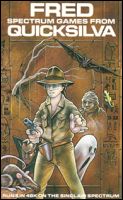
IN FRED, from Quicksilva, which runs in 48K you are invited to guide the intrepid hero round such a dank and deadly charnel house. Fred journeys along the passageways by way of the keyboard or a Kempston joystick and ascends shafts by ropes provided conveniently.
The main aims are to collect as much loot as possible and also to find your way from the tomb. That is not a simple task, as the guardians are constantly on the prowl; some, like the ghosts, can pass through walls or teleport down the shafts.
The cartoon-style graphics are attractive and colourful, the passageways scrolling as Fred moves across or climbs the ropes. Motion is smooth and you can define keys to suit your taste. It is a game which takes ingenuity and care to get through and is novel in concept. If you shoot at anything which moves you will not survive for long without more ammunition.
Fred will not appeal to those seeking fast, furious, violent action but it is well-designed and fun to play, though it may not be addictive in the usual sense. Watch for flying mummies.
| FRED | Memory: 48K | Price: £6.95 | Joystick: Kempston | Gilbert Factor: 6 |
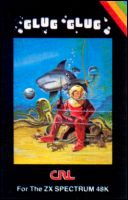
deep. While you are down there, get rich quick by bringing up the treasure lying on the ocean floor. That is the basic story-line of Glug Glug, an arcade game by CRL for the 48K Spectrum.
Using the keyboard, Kempston or Protek joystick, the diver figure must be dropped to the sea bed as quickly as possible to pick up various items of plunder. The skill is in avoiding the animal life below the surface - piranhas, sharks, giant squid, jellyfish and the like, all of which are looking for a fast meal. If you are not fast enough with the gun and winch then it is Davey Jones' locker for you.
Instructions are laid out clearly on the insert and the graphic display is smooth and fast. The sound is suitably watery and when you are caught by the fish the diver vanishes with the requisite glug-glug. There are 32 skill levels according to the cassette insert. After level seven things hot up considerably and you will be lucky to get the whole way through.
| GLUG GLUG | Memory: 48K | Price: £5.95 | Joystick: Kempston or Protek | Gilbert Factor: 6 |
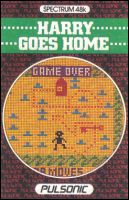
AN INGENIOUS idea saves Harry Goes Home from Pulsonic from being altogether negligible. Written in Basic, the program features primitive graphics and slow action but it provides an absorbing game which calls for some fine strategic thinking.
Harry has for some reason to cross a minefield, picking up a key on his way, to enter his house.
The mines are not shown but at the top of the screen after each move is a report telling you whether there are one, two or no mines beside Harry.
With care and forethought, it is possible to pick one's way through the mines but getting Harry home leads only to another more difficult screen with more mines.
At the end of each screen, you can press a key to see where the hidden mines were. You are also told how many moves you made before reaching home or being blown up.
Clear presentation adds appeal to a simple game which makes good use of the response potential of the computer.
| HARRY GOES HOME | Memory: 48K | Price: £2.95 | Gilbert Factor: 6 |
HURG is not a game but a games designer. Melbourne House claims it is the most powerful game design program ever presented on any microcomputer. That may be so, and it may not. It is certainly a competent program to help you design arcade games but it necessarily limits the scope you have. You will not be able to create a new version of Manic Miner or Atic Atac. You will not even be able to emulate the Melbourne House Penetrator. You will, however, after many hours of practice, be able to create your own version of Donkey Kong or Galaxians without too much difficulty.

There are several impressive features to the program. First, it is menu-driven, like the Quicksilva Games Designer. On loading, you are presented with a series of choices on the screen. Choosing 'Play Game' allows you to test whatever game on which you are working. Choosing 'Edit Game' will take you to a new menu with more choices, like writing a title page or specifying conditions for proceeding to a new stage of the game - e.g., when all the space invaders are destroyed.
The most striking feature of the program is that it can be controlled almost exclusively by a joystick. All you have to do is use a Kempston and shift the cursor round the screen until you find the option you want. Then you hit the fire button and the choice is made. It sounds simple, doesn't it? It is - and it is not.
There is a fundamental problem with such a program. That is not the fault of Melbourne House, which has produced as good an arcade game designer as any on the market. The problem is that such a program can be only an idiot slave.
If you do not have a clear, detailed concept of the game you want to create you will have an unplayable mess. Good games do not depend on good programming but in the first instance on good ideas. At some stage or other we all buy a turkey. It may have wonderful graphics, be very fast and all the rest of it, but if the idea is not good, the program cannot save it. A turkey may have beautiful plumage but it remains a turkey.
What HURG can do is eliminate much of the tedium of programming - it still takes a long time to create a game but nowhere as long as it would starting from scratch - but what it will never do by itself is give you the originality and inspiration of top games designers.
If you want to get to grips with the problems facing designers, HURG will help you by removing the drudgery from programming.
You may even make money. Melbourne House is offering cash prizes for the best games created with HURG but if you want a game up and running in two hours, forget it. HURG is good but as yet there is no commercial substitute for inspiration.
The program is fully-documented with a 36-page booklet and three example games showing some of the features of the program.
| HURG | Memory: 48K | Price: £14.95 | Joystick: Kempston, Interface II | Gilbert Factor: 8 |
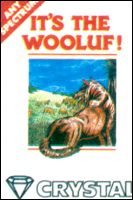
IT'S THE WOOLUF is another of those infuriating sheepdog games where you have to guide your energetic collie round the fields, rounding up the sheep and steering them safely into the pen.
Crystal Computing has provided all the usual hazards - a river, woody copses, and the big bad wolf which sneaks along between the clumps of trees waiting to jump out and devour your dwindling flock.
Although it is a fast-moving implementation, there seems to be no particular reason for releasing another version of an already much-imitated game. Since there is no joystick option, nor any choice of control keys provided, It's the Wooluf seems unlikely to stand its ground against products already on the market.
On the other hand, jaded shepherds with portable power units may derive some light relief from the program.
| IT'S THE WOOLUF | Memory: 16K | Price: £6.50 | Gilbert Factor: 5 |
JERICHO ROAD is that rare thing among programs, an adventure with a moral purpose. You have been transported back to biblical times and must make a journey to Jericho.
On the way you encounter characters from the Bible and participate in stories such as the parable of the Good Samaritan.
Written by a minister - the cassette insert does not indicate from which denomination, so perhaps we can regard this as an ecumenical adventure - the program seems to have a feel for the times.
You can even pray for guidance, which makes a change from the usual adventurer's despairing cry for help and at least some of the hints are in the form of biblical references, sending you flipping through the pages of the good book.
Unfortunately the vocabulary is a little limited and the computer was erratic about accepting standard abbreviations such as W for west.
To compensate, there are a few simple graphics to enliven the text from time to time.
There are two versions, one for novices and one for more advanced players.
If you do not know much about the Bible you had better try the simple version first, or you will probably spend more time languishing in a Roman jail than proceeding with your pilgrimage.
Jericho Road is a gentle, original and enjoyable adventure. How far it will appeal to customers used to more bloodthirsty fare is another matter but it may prove a more digestible alternative to the weekly school divinity period. It is available from Shards Software.
| JERICHO ROAD | Memory: 48K | Price: £5.75 | Gilbert Factor: 7 |
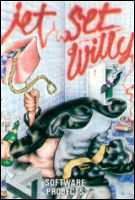
MANIC MINER was one of last year's classic Spectrum games and now programmer Matthew Smith has brought Willy back again in an equally zany sequel, Jet Set Willy. Willy is living the decadent life after striking it rich down the mine but his housekeeper revolts after one party too many and will not let Willy go to bed until he has cleared all the mess.
So you have to guide the debauched playboy round his enormous mansion full of lethal traps and the strange blend of domestic and diabolic mayhem we might expect from Smith on previous form.
It is worth the initial trouble. The graphics are clear, fast-moving, and varied, depicting ghosts, mad monks and animated toilet seats with equal smoothness and precision. Tactics need to be varied as well; only quick reactions will save you from the predatory security guards, whereas forethought is required to negotiate your way through the hazards of the giant Megatree or the unspeakable menace in the kitchens.
Software Projects offers a case of champagne to the first person to solve the game.
| JET SET WILLY | Memory: 48K | Price: £5.95 | Joystick: AGF, Protek, Kempston, ZX, Soundstik | Gilbert Factor: 9 |
DO NOT let the title of Krakatoa from Abbex mislead you into assuming that the volcano will play a large part in the game, which is essentially a chopper attack/rescue format.
As the pilot of a well-armed helicopter in the Java Seas, you will have to overcome a number of obstacles to bring the hapless civilians of Volcanic Island to safety at your base.
Your prime task is to protect a supertanker from the multiple waves of V1 flying bombs which threaten the ship. Submarines also attack from beneath the waves, leaving floating sailors to be rescued.
In the brief interludes between each assault you may also find time to over-fly the spewing magma of the volcano and attempt to rescue the villagers by winching them up. The chopper will need rearming and fuelling at various times and you lose precious time in that way as the tanker is undefended in the interim.
Abbex has produced a slick and compulsive arcade game with clear, steady graphics and a fast-moving and difficult scenario. In addition, the lower screen contains long-range radar and other status indicators. Movement of the chopper is by keyboard only, which is perhaps the only major flaw in the program, apart from the brief screen display explaining the movement keys.
There are no printed instructions on the insert. Nevertheless, it is a quality game for the 48K Spectrum, highly addictive and entertaining. You will face many problems in deciding priorities and your flying ability will be pushed to the limit.
| KRAKATOA | Memory: 48K | Price: £5.95 | Gilbert Factor: 8 |
LETTERFONT from Allanson Computing is a utility program which will give you up to six type-styles on a 48K Spectrum. There is also the option to design your own. The type-styles available are Countdown, a modern hi-tech type face, italic, typeface similar to that of an old-style typewriter, bold, gothic and sync, based on the typestyle of the Sinclair logo.
The program can load any or all of those and works by altering the system variable CHARS at addresses 23606 and 23607. They are used to point to the character set, normally held in ROM.
When you want to design your own type-style you are presented with an 8 x 8 grid, as in the Horizons tape, and can use either one of the defined characters or start from scratch. You can also copy styles from one set to another. Details are included to save the styles and then use them in your programs.
The idea of having different characters is not new but this is a reasonable implementation; only three of the six sets will probably be of any use but the number you can create is infinite.
| LETTERFONT | Memory: 16K | Price: £4.95 | Gilbert Factor: 8 |
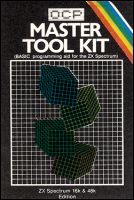
MASTER TOOLKIT by OCP for the 16K/48K Spectrum is a collection of 27 routines to make programing easier. The routines include a clock, with alarm, which can be displaying the time continually, even when back in Basic, and routines to delete, renumber lines, find, list or substitute a given string for another string or variable and display a list of variables. You can delete all REM statements, lower RAMTOP and print the amount of free memory.
The useful routines are Trace, where each line number is displayed as it is executed and ON ERROR GO TO and BREAK, where when the program stops running and tries to print a report code, i.e., when BREAK is pressed, a jump is made to a specific line.
The Pack routine squeezes as much as possible into multi-statement lines, taking note of IFs, REMs and GO TOs.
You are also given 10 programmable function keys, which can be used from Basic. It is very comprehensive and worth buying if you do much programming.
| MASTER TOOLKIT | Memory: 16K | Price: £9.95 | Gilbert Factor: 7 |
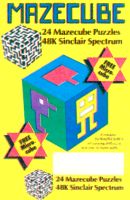
MAZECUBE for the 48K Spectrum by PAL Software is a new idea in maze games. The maze covers the six sides of a cube and there are 48 pound notes which the little man has to pick up. When he picks up a note a gate blocks his path at that point. The number of paces taken to pick up all 48 are counted and the winner is the one with the least. To make things more interesting there are 24 mazes, plus one for practice.
As he moves round the maze you can rotate it to view it from different sides and the man also changes profile. To help you recognise him the instructions include a cube which can be cut out to make a maze man.
It is a well-implemented idea. It would have been marginally better if the cube could have been bigger but overall it is well-thought-out. The game is written entirely in Basic, which shows you do not necessarily need machine code if the idea is right.
| MAZECUBE | Memory: 48K | Price: £6.95 | Gilbert Factor: 6 |